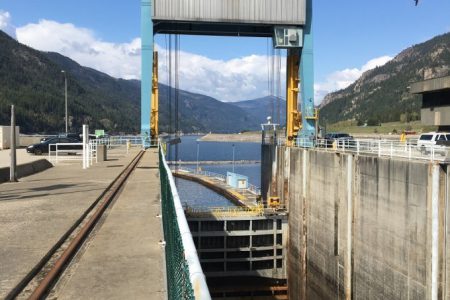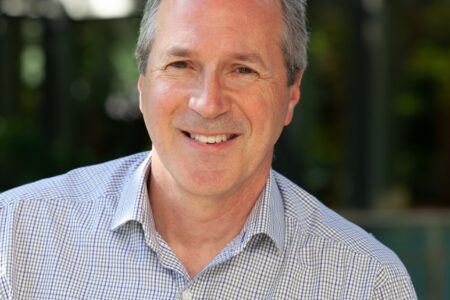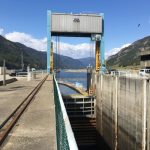Dam road closure not a "done deal" after all
More than 30 people showed up to hear B.C. Hydro back off its stance regarding the permanent closure of the High Keenleyside Dam road Thursday evening.
The meeting, held at the Sandman Hotel, was originally intended as merely an “informational” session in which B.C. Hydro could answer questions and hear public reaction to the closure, but senior manager of community relations Lawrence Pillon told the assembled crowd that, “We have a made a decision to step back from the permanent closure of the road.”
The road will still be closed Sept. 14, but will re-open around Nov. 30, after an initial assessment of maintenance and upgrade requirements has been completed.
Pillon said the company will have a better sense, at that time, of what work is required and the timeframe necessary in which to complete it, and the road will likely remain open until the upgrade project gets under way in the autumn of 2010, and may then remain closed for up to three years while work is completed.
Director of southern operations for B.C. Hydro, Cheryl Bucar, said the next, most immediate step in the permanent-closure decision will be to get an audience with Castlegar city council, offering a thorough presentation of the situation as outlined by the assessment process, then to proceed with public consultation.
She said B.C. Hydro currently operates 42 dams, 10 of which boast varying degrees of public road access, and some of those 10 employ controlled access measures including gates, fences and 24-hour-a-day guards – so there are options beyond permanent, complete closure.
B.C. Hydro stakeholder engagement advisor Rachel Hamilton also said any final decision would be managed in consultation with local emergency services officials to ensure timely access for emergency vehicles should a closure ultimately take place.
Former mayor Michael O’Connor asked whether the original decision to close the thoroughfare was based, as B.C. Hydro representatives originally suggested, on security (terrorism) issues, or on later contentions that safety was the primary concern.
Bucar responded that the confusion over the safety/security rationale was likely because both issues are at play: the security issue largely in the wake of the 9/11 terrorist attacks that felled the twin towers of the World Trade Centre in New York.
“We didn’t do a very good job of de-coupling those (security versus safety) or of clarifying either,” she said.
In terms of terrorism, she explained there were two criteria to be considered when assessing the risk factor at a dam.
“We looked at the consequences of a terrorist act being successful at a (given) dam, and the probability of a terrorist event happening at a (given) dam.”
She said the High Keenleyside dam was assessed as a low-probability, but high-consequence dam – which left it low on the list of priorities, while other, more at-risk dams were re-vamped with enhanced security in mind.
“The probability is very low, but should it (a successful terrorist attack) happen, the consequences would be very, very high,” she said, explaining this assessment factors in potential property and environmental damage as well as loss of life. She said in the interests of exercising due diligence, B.C. Hydro has to mitigate that potential whenever, and wherever, possible.
“Do I think something bad could happen here?” she said. “Absolutely.”
As to the safety issue, B.C. Hydro’s Neal Dermody concurred that there have been few problems during the more-than-40 years the dam road has been open to the public – but added that was more due to luck than anything else.
“B.C. Hydro would like to take luck out of the equation,” he said, adding ultimate safety is achieved through identifying hazards and eliminating those hazards altogether.
Bucar stepped in and added that, in the years of 2003 through to 2005, B.C. Hydro enjoyed the dubious distinction of being the leaders in worker fatality statistics across all Canadian utilities, which changed B.C. Hydro’s paradigm in terms of guarding worker safety.
“Our workers have an opinion, too, and they take priority,” she said, adding workers had said they felt unsafe, and needed to concentrate on their jobs while on-site, not on what a passer-by cyclist or motorist may or may not be doing.
Area J director for the RDCK, Gord Zaitsoff, said he took issue with the lack of communication on B.C. Hydro’s part when it comes to periodic closures of the dam road, and suggested it was an intentional tactic on B.C. Hydro’s part to, “get residents accustomed to using Broadwater Road” instead of the dam thoroughfare.
“That communication has to change somehow,” he added.
Bucar agreed.
“We need to do a better job of explaining the work we’re doing in your communities, at our facilities,” she said.
She also said special circumstances, such as alternate routes becoming impassable and thus causing a heightened need for the dam road, would be managed on a case-by-case basis when and if the dam road itself was closed.
When asked if B.C. Hydro had budgeted or committed a specific dollar amount to furthering mitigation measures in the event of a closure, such as improvements to an alternate route like Broadwater Road, Bucar said no.
“Our commitment is to work with the Ministry of Transportation. There’s no dollar figure that I can give you on that, though,” she said. “Typically, we don’t give dollars…but that’s situational.”
Pillon said the community has not heard the last of the issue, or from B.C. Hydro.
“We’ll come back to you in, hopefully, a short period of time, to provide a timeline and a process,” he said.



























Comments